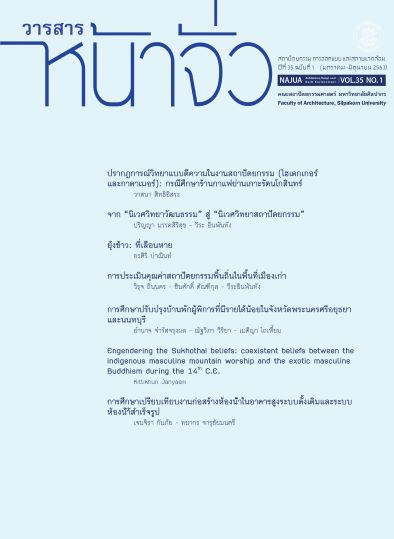The Evaluation of Vernacular Architecture’s Value in an Old Town
Keywords:
Cultural Heritage, Vernacular Architecture, Evaluation, Old Town, Historic PlaceAbstract
An old town or historic area is invaluable cultural heritage with vernacular architecture which significantly shapes architectural history. This study aims to establish criteria for assessing the value of vernacular architecture in Thailand by focusing on historic districts as the area of study, and to appreciate the value of the architecture as mentioned. The research method is developed by working on theories and concepts of cultural heritage, old towns, vernacular architecture, and the evaluation criteria of an international organization which is the UNESCO and those of national institutions, namely the Fine Arts Department and the Association of Siamese Architects in order to analyze and lay down the criteria specifically for vernacular architecture evaluation for old towns to correspond with vernacular architecture and cultural heritage conceptions.
The study reveals that although the UNESCO has extended the boundary of the heritage conservation area to cover vernacular architecture, this category is still neglected in Thailand because the Fine Arts Department continues to apply its criteria for listed buildings and focus on restoring architecture with profoundly historical and archaeological value, notable religious places and buildings of the authority by mainly preserving the original form and authenticity. Moreover, the law mechanism for conserving and enlisting historic sites is complicated. All of these contradict present-day conservation concepts of which value is not limited to ancient places or only physical appearance but includes other principal aspects. The analysis and benchmark of cultural heritage value and the criteria of the organisations involved leads to the recommended evaluation criteria for vernacular architecture in old towns, which consist of four features: aesthetics, history, technology and education, and society. It is believed that these criteria are proper and relevant to today’s conservation perceptions.
References
- ICOMOS Thailand. Kodbud Rawang Prathet (In Thai) [International Charters] [Online]. Accessed 10 December 2017. Available from https://www.icomosthai.org/charter.htm#h0
- ICOMOS Thailand. Thai Charter on Cultural Heritage Site Management (In Thai) [International Charters] [Online]. Accessed 10 December 2017. Available from https://www.icomosthai.org/THcharter/63546_Charter_updated.pdf
- Khanjanusathiti, P.(2009). Kan Anurak Morradok Sathapadtayakam Lae Chumchon. (In Thai) [Architectural and Local Heritage Conservaiton]. Bangkok: Chulalongkorn University Press.
- Kirdsiri, K. and Buranaut, I. (2018). “The Charter on the Built Vernacular Heritage”. NAJUA: Architecture, Design and Built Environment, 33, C17-C20. Retrieved from https://so04.tci-thaijo.org/index.php/NAJUA-Arch/article/view/130630
- Office of the Permanent Secretary, Ministry of Culture. Kantrimkan Namsanoe Lang Morradok Pheua Kheun Banchee Morradok Lok. (In Thai) [The Preparation for Heritage Site Nomination for the World Heritage]. Bangkok: Sahamit Printing & Publishing Co. Ltd., 2012.
- Office of Natural Resources and Environmental Policy and Planning. Chut Khwamru Dan Kananurak Pattana Lae Borrihanjadkan Muang Kao Lamtee Nueng (In Thai) [The Knowledge Series on Old Town Conservation, Development and Management Book 1] [Online]. Accessed 10 December 2017. Available from http://lib.mnre.go.th/index.php/2012-04-30-03-57-01/2012-10-12-09-13-14/234-2012-10-29-07-15-05.
- Oliver, P. Encyclopedia of Vernacular Architecture of the World: Volume 1: Theories and Principles. Cambridge: Cambridge University Press, 1997.
- Pitiyanuwat, S. (2016). Withiwittaya Kanpramoen: Sart Haeng Khunkha. (In Thai) [Evaluation Methodology: Science of Quality Evaluation]. 6th edition. Bangkok: Chulalongkorn University Press.
- Sudchaya, C. (2009). Kan Anurak Muang. (In Thai) [Urban Conservation]. Bangkok: Amarin Printing & Publishing.
- Temiyaphan, W. (2016). Sathapadtayakam Pheunthin. (In Thai) [Vernacular Architecture; A Collectionof Academic Articles on Vernacular Architecture]. 2nd edition. Bangkok: Triple Group.
- The Association of Siamese Architects. (2010). Phumpunya Chaowbaan Su Sathapadtayakam Pheunthin. (In Thai) [Folk Wisdom to Vernacular Architecture]. Bangkok: Plus Press.
- The Association of Siamese Architects. (2017). Rangwan Anurak Sillapa Sathapadtayakam Deeden Prajampee 2560 (In Thai) [ASA Conservation Award 2017] [Online]. Accessed 10 December 2017. Available from http://asa.or.th/asaconservation\award2017/
- The Australia ICOMOS Charter for Places of Cultural Significance. (2013). The Burra Charter.
- UNESCO. Operational Guidance for the Implementation of the World Heritage Convention [Online]. Accessed 13 August 2017. Available from http://whc.unsco.org/en/guidelines





